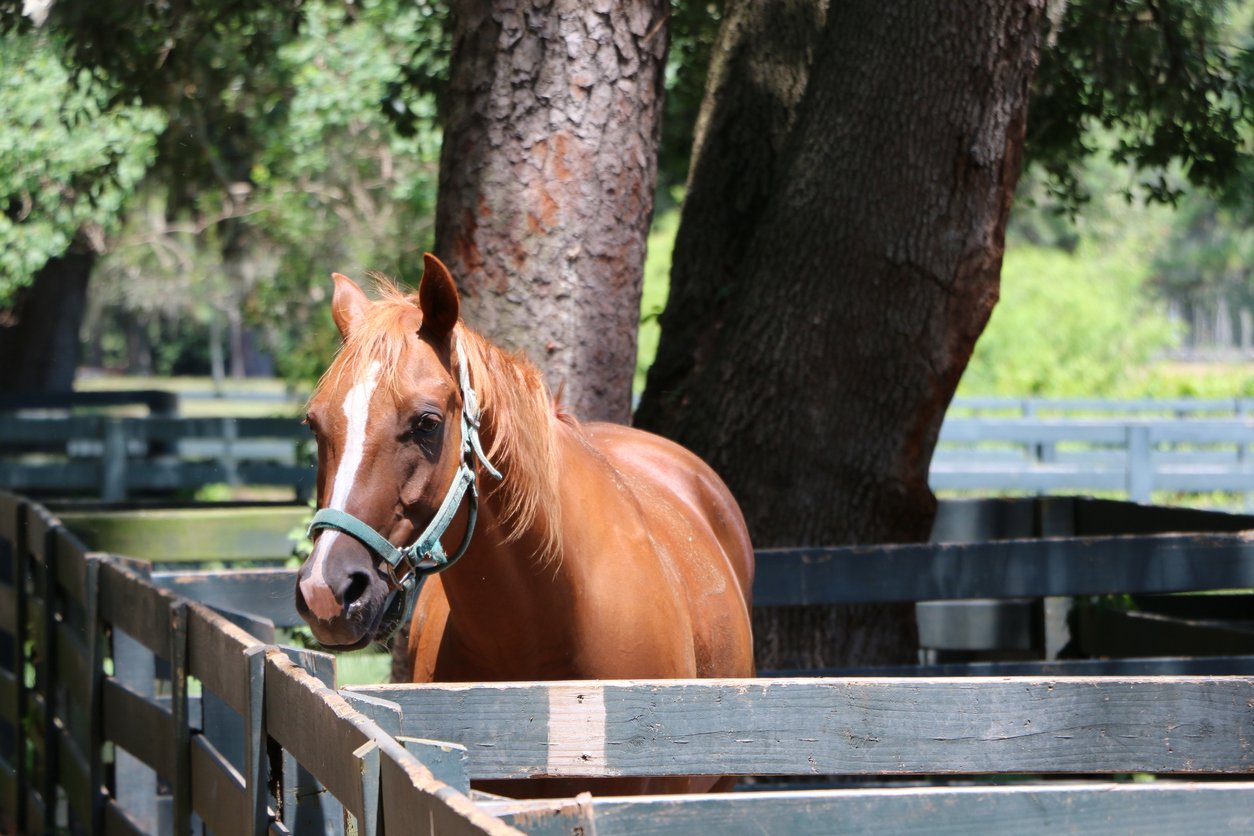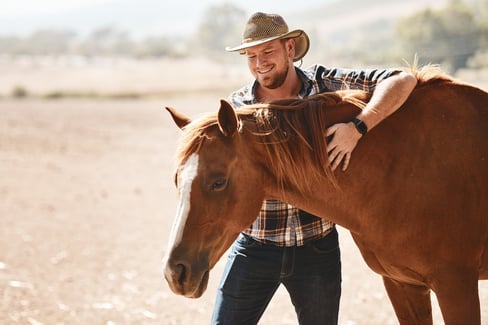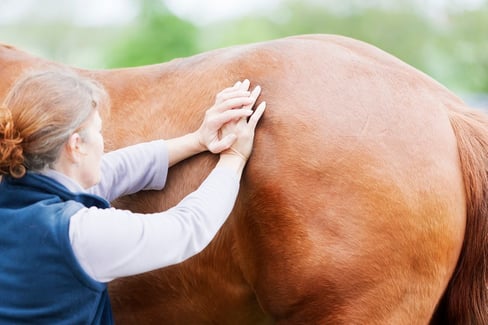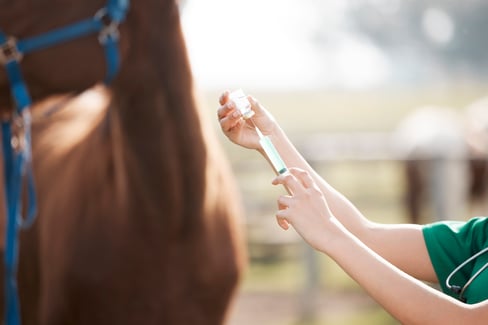Table of Contents
Summer might be the ideal time to ride your horse, as the sunny weather beckons us outside to enjoy every minute of it. But while the sunshine is welcoming, soaring temperatures can significantly affect your horse—especially while exercising.
If you’ve ever been outside when it’s hot and suddenly felt dizzy, disoriented, and needed to sit down, you might have experienced heat stroke.
Just like us and other animals, horses can get heat stroke, which can quickly go from just needing to have a bit of water to cool down to a serious condition that requires immediate medical attention.
Horses release a lot of heat from their bodies, which can make keeping them cool a bit difficult, especially in very hot weather. When your horse’s body is no longer able to regulate temperature through normal processes like sweating, heat stress, which leads to heat stroke, can occur.
Individual horses will also cope with sunny and hot weather differently; for instance, horses that are raised in colder climates and suddenly transported to hotter ones. Stress and disease can also contribute to the development of heat stroke in horses.
It’s important to get to know what’s normal for your horse in terms of how they cope with hot temperatures and what their stress level is like and take steps to ensure that they are comfortable and protected from developing heat stroke.
In this article, we explore the conditions that can lead to horse heat stroke, what action you can take if a horse gets heat stroke symptoms, preventative measures, and much more.
What Is Heat Stroke in Horses
When the weather is hot and humid, horses can quickly become overheated. Horses are big animals and produce a large amount of heat just from doing normal activities like digesting food and exercising.
Like people, horses will sweat to cool themselves. The sweat cools the skin through evaporation, which normally helps to control your horse’s body temperature.
- Heat stroke occurs when the horse’s ability to sweat breaks down, and they are no longer able to adequately control their body temperature.
- The inability to sweat is called anhidrosis and is believed to be caused by an excess of stress hormones that cause the sweat glands to overstimulate.
- Partial anhidrosis is the most common form of the condition, as most horses don’t stop sweating completely unless they are really in danger and are experiencing hyperthermia (like hypothermia, but for heat instead of cold).
- Anhidrosis is common in performance equine, but any horse can experience it. There is even some anecdotal evidence that lack of sweating is more common in dark-coloured horses compared to light-coloured ones.
There isn’t really a definitive body temperature reading for horses that undeniably determines that they have heat stroke, as some performance horses have had body temperature readings above anywhere from 42 to 43 degrees Celsius (107—109 degrees Fahrenheit) with no adverse effects.
However, some studies have shown that once a horse’s body temperature reaches 43.5 (110.3 degrees Fahrenheit), evidence of heat stroke becomes apparent. Given the fact that this temperature is only a mere .5 degrees higher than horses observed with no ill effects, it’s clear that horses need to be carefully observed for signs of heat stroke. It’s also important to realize that the original temperature reading was done in performance horses that are used to exercise, so regular domestic horses are likely to feel the effects of heat stroke at lower temperatures.
A horse that’s experiencing heat stroke can go from simply breathing heavily and sweating to convulsions that can lead to death very quickly if the condition isn’t given immediate attention.
Causes of Horse Heat Stroke

There are a variety of causes of heat stroke in horses aside from your horse just being in the hot sun for too long. Understanding what conditions can lead to heat stroke is important for prevention, especially since some of the potential causes of horse heat stroke are less obvious.
1. Extreme Heat
Super hot conditions are not ideal for large animals like horses. Horses are one of the few mammals aside from humans that sweat to keep themselves cool, but hot weather combined with activity like exercise or work can quickly negate the effectiveness of sweating. Plus, an overheated body means more sweat—which leads to your horse getting dehydrated quicker.
Limiting exercise when it’s hot out is a good idea, and of course providing your horse with plenty of clean, fresh water to drink.
2. Poorly Ventilated Stalls, Trailers, or Barn
You might think that if a horse is in a stall, trailer, or barn where they are shaded from the heat, their chance of getting heat stroke lessens. However, these structures are great at keeping heat inside. Just like it’s a terrible idea to leave your dog or cat in a car even when the windows are cracked, leaving your horse confined in a small area with little ventilation can exacerbate heat stress, which can quickly progress into full-blown heat stroke.
3. Not Consuming Enough Water
If your horse is focused on working or exercising, they may not consume enough water. Make sure to not only provide plenty of water sources for them to conveniently drink from but also give them ample breaks to drink. Given that horses sweat, they can lose a ton of water during hot days, so it’s important to encourage them to drink more than usual.
4. Horses Not Accustomed to Hot Weather (Transported From Cooler Climate)
It’s not uncommon for horses to be purchased and transported from other areas that have warmer or cooler climates. The United States, for example, has one of the highest total populations of domesticated horses in the world, with southern states leading the pack. Given the fact that every state has a hand in breeding and raising horses, it isn’t hard to imagine that horses are bought and sold from around the country.
But a horse going from a cooler state to one with hotter weather, like Pennsylvania to Florida, for example, is going to need some time to adjust to the new weather. In a case like this one, you’ll want to ensure that the new horse is given time to slowly acclimate by keeping them in a well-ventilated barn or stall and letting them out into the heat for short intervals. Of course, they should always have plenty of fresh, cool water to drink as well so they stay hydrated, as they may sweat more than a horse that’s used to the climate.
5. Obesity
Overweight or obese horses can have a harder time dealing with the heat compared to a horse that’s at a healthy weight. This is because fat is an insulator and works to trap heat, making it more difficult for your horse’s body to cool itself down with normal processes like sweating. Keeping your horse at a healthy weight, especially when they live in a hotter climate, is important to prevent heat stress and heat stroke in your horse.
6. Trauma or Stress
During times when you were under a lot of stress or experienced a traumatic event, you can probably recall your heart pounding, breathing getting quicker and heavier, and possibly feeling sweaty or weak and faint once the adrenaline wore off. Just like people, horses can have significant reactions to stressful events that can affect their body’s ability to regulate its temperature.
Trauma or stressful situations can include:
- Transport
- Wild animal attacks
- Attacks from other horses or animals at a farm
- Excessive work or exercise
- Lack of food or water
- Being cooped up in a stall or barn for too long
There is evidence that suggests that when horses are stressed, have experienced trauma, or have medical conditions that lead to significant dehydration (such as diarrhea) can experience heat stroke, even when the temperature outside isn’t high.
7. Excessive Work
When it’s hot outside, it’s important not to work your horse too hard. The combination of external heat and rising body temperature due to working often makes the perfect cocktail that leads to heat stroke in horses.
If your horse must work in the heat, be sure to give them plenty of breaks and provide ample cool water for them to drink. However, the best course of action is to skip work when it’s too hot and simply allow your horse to relax in shaded areas to prevent overexertion.
TRI-ACTA H.A. for Equine
Our maximum strength formula is perfect for horses that are ageing, experiencing arthritis and stiffness, are in training and competition, or under a heavy workload.
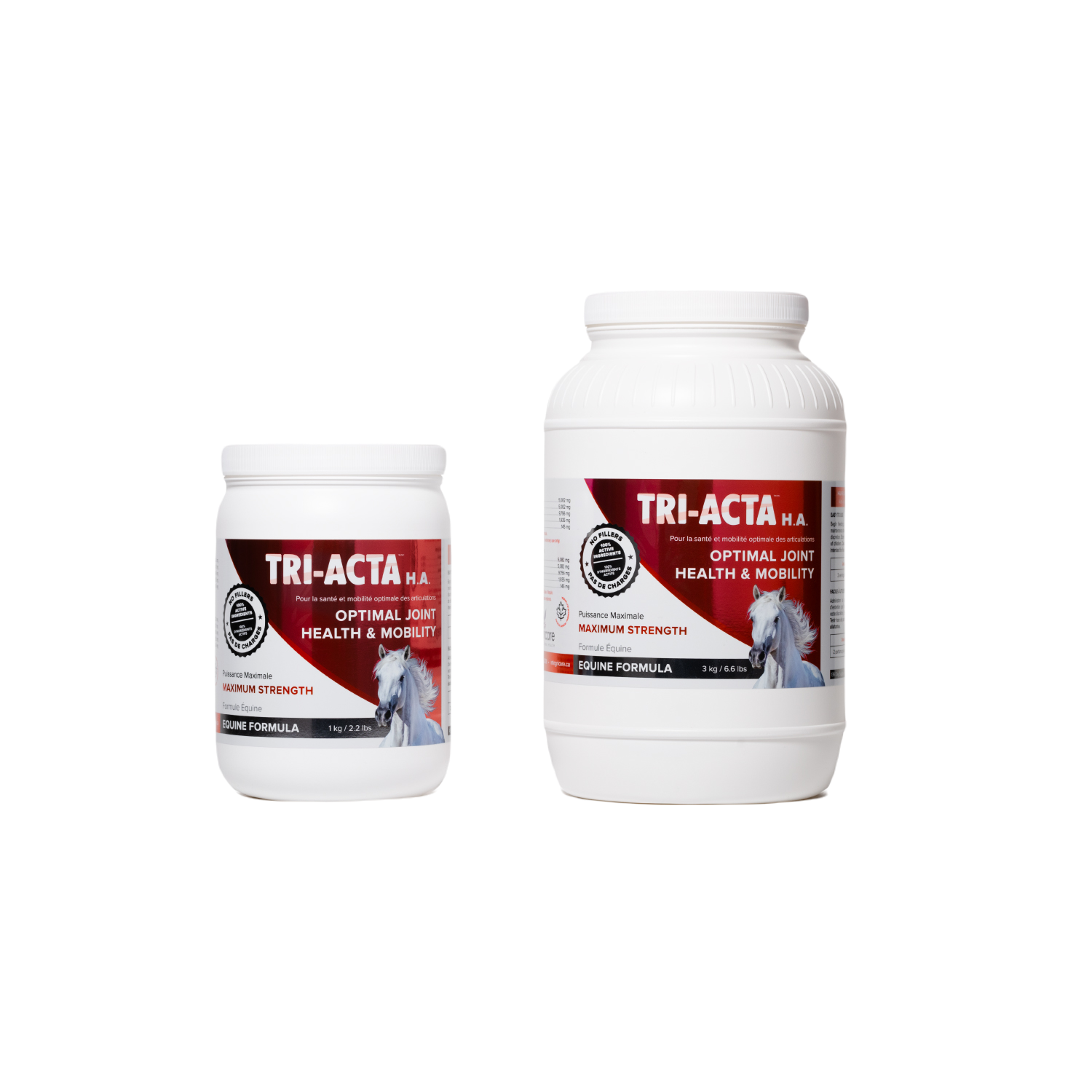
Signs of Heat Stroke in Horses
A sign indicates something is amiss with your horse. Given the fact that heat stroke in horses can manifest quickly, it’s important to be completely aware of the different signs of horse heat stroke so that you can take immediate action to get your horse’s body back to an ideal temperature.
1. Profuse Sweating or Less Sweating Than Expected
Earlier in this article, we mentioned a condition called anhidrosis, where a horse cannot sweat as much as they should to maintain their body temperature. If a horse can’t sweat or is clearly not sweating as much as they should be given the heat, it’s a significant warning sign that something could be wrong.
But on the other hand, excessive sweating can also be a good indication that your horse is overheated. If your horse has longer hair, sweat might be easier to spot as their hair will become visibly matted and wet-looking. However, if you have a horse with shorter hair, excessive sweating can be harder to spot—meaning you might have to go up to your horse and give them a pat to see how much they are sweating.
If they are sweating a lot, move them to a shaded area and give them cool (but not cold) water. If they’ve stopped sweating completely or show other signs of heat stroke in horses, like anxiety or fearfulness, then it’s a good idea to consult a veterinarian immediately for the next steps.
2. Skin that is Hot to the Touch
If your horse has skin that feels uncharacteristically warm or hot to the touch, that could be an indicator that they are experiencing heat stress or stroke. You can slowly pour cool water onto your horse to help them cool down but don’t use cold or ice-cold water as it can cause a shock to their system.
3. Short and Stiff Gait
When a horse is experiencing heat stroke, the normal processes in their body lead to tie-up or rhabdomyolysis (painful, uncontrollable, continuous muscle contractions). Tying up occurs because your horse’s body doesn’t have enough electrolytes, so their horse muscles cannot respond properly to movement. Lack of electrolytes can be caused by excessive sweating due to heat, meaning that any nutrients that your horse had in their body are leaving them via sweat. Ensuring that your horse is consuming enough nutrients and getting enough water throughout the day is essential for preventing this condition.
4. Rapid Breathing
If it’s hot outside and your horse starts breathing heavily, it could be a sign that their body isn’t getting enough oxygen due to the heat. Stand next to your horse and measure their rate of breath. Call your veterinarian immediately if they are breathing more than 50 breaths per minute.
5. Rapid Heart and Pulse Rates
Like breathing rate, your horse’s heart rate can also significantly increase if they are suffering from heat stroke. The normal heart rate of an adult horse should be between 30-40 beats per minute. If your horse’s heart rate exceeds 40 beats per minute, you should immediately calm them down and cool them off. However, if your horse’s heart rate exceeds 60 beats per minute, this warrants an immediate call to your veterinarian.
Heat Stroke in Horses Symptoms
Symptoms refer to abnormal changes in your horse’s body that they are actively experiencing. Because we can’t sit down with our horses, ask them what’s wrong, and have them tell us in English, we have to rely on other ways to determine if they are experiencing anything unusual in their bodies.
One of the most effective ways we can do this is by observation. If a horse is in pain or uncomfortable, like most other animals, they will try to hide their pain. This is because they don’t want to alert the other members of the herd of their weakness, as horse herds will leave a sick horse behind because they are slow and weak, and slow and weak animals attract predators.
As a result, recognizing heat stroke in your horse requires careful observation, awareness of the animal’s usual behaviour, and using tools and techniques to factually check for heat stroke in horses symptoms.
Behavioural Changes
A horse suffering from horse heat stroke usually progresses from being dull or listless to suddenly becoming panicky and manic as the condition worsens. You know your horse the best, so be aware of their body language and any off changes in behaviour that could indicate something is wrong.
Body Temperature
Thankfully, we can measure the body temperature of horses to help us determine if they are potentially suffering from heat stress or stroke. As we mentioned earlier in this article, there isn’t a surefire temperature that says, “Yes, your horse is suffering from heat stroke”, rather the temperature is just another piece of evidence to add to the pile.
Here is a handy chart that outlines the temperatures that are considered “normal” and when you should seek veterinary care:
|
Horse Body Temperature |
Indication |
|
Within the normal temperature range for most horses |
|
Fever, which should be examined by a veterinarian |
Dehydration
Symptoms of dehydration can be an indicator that your horse might have heat stroke. Lack of skin elasticity (gently pinch your horse’s skin. If the skin doesn’t immediately go back to its normal state, it’s a dehydration symptom) sunken eyes, tacky membranes, and lack of urination are all indicators that your horse lacks the moisture their body needs to function normally.
Horse Stroke Treatment
If a horse gets heat stroke symptoms, time is of the essence. If left untreated, heat stroke in horses can cause brain damage, and organ damage, and even cause your poor horse to go into convulsions—and eventually pass away. That’s why it’s so important to take action immediately with horse stroke treatment options that you can perform while you wait for a veterinarian to arrive.
|
Horse Stroke Treatment (Heat-Related) |
Instructions/How it Helps |
|
Place the horse in a shaded area |
Moving your horse to a shaded area of course doesn’t reduce the temperature that they are being exposed to, but it gets them out of the sun. The sun’s radiation can make it feel up to 10–15 degrees hotter compared to in the shade. |
|
Provide air movement with a fan |
Moving air helps the sweat on your horse’s body evaporate, which cools their skin. |
|
Gradually wet your horse’s entire body |
Starting from the legs and gradually moving up your horse’s body to its back and head, use cool (not cold) water to get your horse’s body temperature down. Cold water isn’t recommended because it could shock your horse’s system. |
|
Offer an initial bucket of saltwater |
Mix 90 grams of salt into a 10-litre bucket of water and offer small portions of the water to your horse at a time. The salt helps rehydrate your horse quicker than just plain water alone. |
|
Provide small amounts of drinking water at a time |
You don’t want to shock your horse’s system by giving them too much to drink at one time, as it could add stress to their kidneys. Instead, offer small buckets of water at a time and wait 5-10 minutes between offerings. |
|
Get your horse IV hydration therapy if necessary |
If your horse is completely dehydrated, they might require IV therapy to replace the essential nutrients they lost. This therapy can be provided by a veterinarian. |
How to Prevent Heat Stroke in Horses
Prevention is the key to making sure your horse never has to deal with the dangers of heat stroke. Key preventive measures that you can take include:
1. Provide Shade
The easiest way to prevent heat stroke in horses is to provide them with plenty of shade. Trees and stalls are great ways to provide your horse with shade on a hot day. Just make sure that stalls are ventilated properly—you want to give your horse a place to cool down, not make themselves hotter in a confined space.
2. Provide Access to Clean, Cool Water
Water is extremely important in keeping your horse hydrated and able to deal with the heat of the day. Leaving troughs out for days at a time isn’t a great solution as the water will become hot and full of bacteria. Instead, change out water regularly so that your horse always has access to clean and cool water that will help them keep their body temperature where it should be, and prevent dehydration. Providing a salt lick alongside water is another good way to ensure that they replace the electrolytes they lose from sweating.
3. If You’re Near a Water Source, Spray Your Horse with Cool Water Occasionally
Lightly spraying your horse with water or pouring water over them can go a long way in helping them keep cool. If their paddock or pasture is near a water source, creating a misting area is a good way to let them come and soak themselves when they please without you having to constantly go out and spray them with water yourself.
4. Reduce Ride Time and Work Intensity
While a hot Summer’s day may seem like the ideal time to ride your horse, the heat of the day may prove to be too much for strenuous exercise. Reduce ride time to early mornings or evenings when the temperature is lower, and if your horse is a working horse, go easy on them during the day to prevent heat exhaustion from setting in.
5. Clip Horses With Longer Coats
Fur coats are beautiful, but not when it’s super hot outside! Just like you’d put a jacket on a horse to protect them from the cold, it’s a good idea to groom your long-haired horse and clip that extra fur so heat can escape from their bodies more easily.
Summary
If you have a horse, taking the appropriate measures to prevent horse heat stroke symptoms is paramount. Untreated heat stroke in horses can quickly lead to organ failure, convulsions, and finally death. Ensuring that your horse has enough water, and shade, and is closely monitored during any work or exercise is essential for preventing heat stroke.
Top-notch horse health is the highest priority for any horse owner. One of the ways that you can do that is by taking the appropriate measures to ensure that your horse doesn’t get any serious illnesses or conditions, like heat stroke. Part of that process is making sure their bodies are strong and can withstand changing conditions. Supplements can help strengthen your horse’s body, from their digestive system to their joints. Joint issues in particular are extremely common in horses, meaning that providing them with a joint supplement from a young age is important.
TRI-ACTA is a horse supplement for joints with 100% natural ingredients, including two types of glucosamine, chondroitin, and MSM. It’s a great daily supplement to give to your horse to prevent the development of joint issues. If your horse already suffers from some sort of joint issue, consider giving them our extra-strength version, TRI-ACTA H.A, instead. The “H.A.” stands for hyaluronic acid for horses, which gives your horse’s joints more lubrication to facilitate easier movement.
TRI-ACTA H.A. for Equine
Our maximum strength formula is perfect for horses that are ageing, experiencing arthritis and stiffness, are in training and competition, or under a heavy workload.

Buy TRI-ACTA products by clicking on the links above, or learn where to buy at a store near you.
Newsletter Signup
Subscribe to our newsletter to receive the latest news and exclusive offers.
.jpg?height=2000&name=Cliick_Integricare-DISPLAY-REVISEDV2%20(1).jpg)
Proactive & Therapeutic Joint Supplements
When given daily, Integricare joint supplements recover bone and joint injuries faster and help prevent mobility injuries from happening in the first place.

